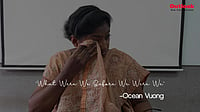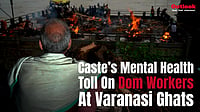Surprises and learning never cease. That's a platitude, you may say, but when the two play out in detail and in consonance, they produce an uncommon joy. I had an occasion to experience it in the light of a linguistic discovery recently.
I had gone over to meet a friend visiting Bangalore, who was staying with his niece. At the dinner table, the host and her husband were communicating in a language that sounded in small parts like Kannada, in a few parts like Telugu and in good parts like Tamil. There were no nasal sounds, so I assumed there was no Malayalam. It was not one of the important dialects of any of these major Dravidian tongues, nor was it Tulu or Konkani that I was familiar with. Given their social profile and geographical position they could have been speakers of any of these languages, but they spoke none. Unable to contain my curiosity I asked what was it that they were speaking? Both Girija and Venkatesha Murthy, in their sixties perhaps, said that their language had no name. "We sometimes call it 'Engalode Vathe,' literally meaning 'our tongue'." I had heard of script-less languages, but here was a nameless one.
While Murthy, who is a retired Physics professor, felt extremely happy about my enquiry and confessed that he was a passionate user of his tongue and wouldn't let it die, Girija said that she had taken to it only after her marriage to Murthy. Her parents, during her growing up years in Kolar district, had insisted on Kannada, the official and dominant tongue that ensured mobility. But Murthy declared: "My father spoke to me in this language and I made it a point to speak to my two sons in our language. Now they are settled in the US but still communicate with me with me in our language."
Apparently, the couple told me, linguists referred to their language as Arava Tamil or Tamil-Kannada. However, they insist that it is a pidgin shaped by its trilingual milieu at a point of intersection on Karnataka, Tamilnadu and Andhra Pradesh border, which is the southern part of Kolar district in Karnataka. If one were to roughly map the habitat of this language, it would start from Anekal taluk in adjoining rural Bangalore and run via Hoskote, Malur, Chintamani, Shidlaghatta and Kolar town. The cultural epicentre of this pidgin is said to be in Kittiganahalli village and its surroundings in Anekal taluk.
The habitat of the language gets decided on the concentration of the Dravida Brihatcharana or Manjaputtur Brihatcharana community, who are Shaivite Brahmins said to have migrated from Tanjore many centuries ago. Murthy insists that it was 700 years ago, but my friend, who is a reluctant speaker of the language, said that one should discount a lot of myth-making and memory with regard to one's heritage. The fact is there is no recorded history of the community. So, no one really knows if they truly migrated from Tanjore and, if they did, what prompted them to do so. Since this pidgin is more or less confined to the Brihatcharana community, some among them take pride in calling it 'Brihatcharana Vathe' or 'Pericharana Vathe'. 'Brihat' and 'Peri' mean 'big' in Kannada and Tamil respectively. However, it needs to be clarified that not all in the community speak the language. They have moved on with the times and their social, economic, as well as geographic mobility. "Some people have an inferiority complex about our language," Murthy complains. In all, just about twelve households speak the language. That would in rough terms put the number of speakers to around a thousand. This linguistic community has an annual assembly in Kittiganahalli, around the month of March (on 'Phalguna Shudda Chaturthi' as designated in the Mysore almanac) to propitiate the snake-god ('Nagaradane'). There are no clear answers as to why it is the snake-god.
Since this language is spoken by a tiny minority and has no grammar written for it, Murthy and Girija, inform that they recognise a certain depletion of its lexicon and mild alteration in its syntax from what their parents spoke, what they held on and what has been passed on to their children. Thus intergenerational transmission losses seem to exist for this language that lives only in the memory of its speakers. Interestingly, for a tongue that has no defined standards, Girija said that her parents spoke a 'purer' variety. I asked how. She instantly gave a few interesting examples: "My granny and mother called roti made out of rice flour as 'vatmu,' but now we use the Kannada term 'akki rotti'. Similarly, a wall was called 'chouru,' but now we have shifted to the Kannada word 'goode.' Also we had a specific word for ginger. We called it 'pachhuku,' but now it the Kannada word 'shunti' that is in use." Given the fact that this is a language spoken by a Brahmin sect, I wondered if it would contain a word for 'meat'? I didn't asked but suggested that Girija should attempt an amateur lexicon for her language. She simply smiled.
One last curious detail about this practically unknown language. My friend said that if I look up the 1971 census of India I would find 'Engalode Vathe' listed as one of the unrecognised languages spoken by one speaker in the Jhalukbari area of Guwahati. How did this language migrate to Assam? That is because my friend was there, then, teaching English at the Guwahati University. To derive a vicarious thrill of subverting a government book of record, he had identified this language as his mother tongue, though he has never been its passionate proponent. I guess its caste-specific association had offended his profound Marxist sensibilities, hence willingly giving it up was a part of his identity, until of course the census mischief struck him.
A Nameless Tongue
I had heard of script-less languages, but here was a nameless one...

A Nameless Tongue
A Nameless Tongue
Published At:
MOST POPULAR
WATCH
PHOTOS
×
















